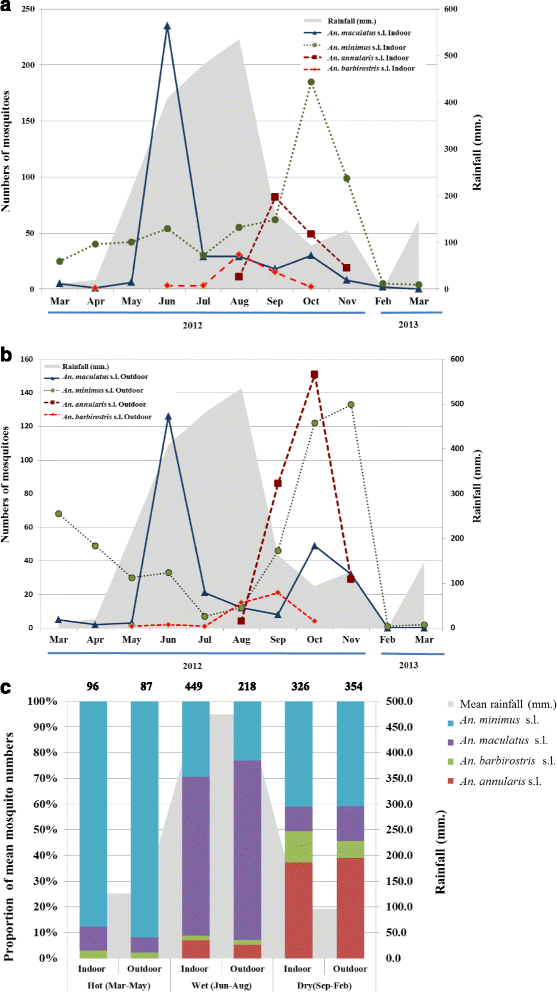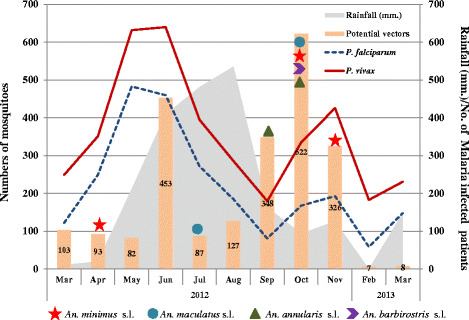Natural human Plasmodium infections in major Anopheles mosquitoes in western Thailand
- PMID: 26762512
- PMCID: PMC4712558
- DOI: 10.1186/s13071-016-1295-x
Natural human Plasmodium infections in major Anopheles mosquitoes in western Thailand
Abstract
Background: The Thai-Myanmar border is a remaining hotspot for malaria transmission. Malaria transmission in this region continues year-round, with a major peak season in July-August, and a minor peak in October-November. Malaria elimination requires better knowledge of the mosquito community structure, dynamics and vectorial status to support effective vector control.
Methods: Adult Anopheles mosquitoes were collected using CDC light traps and cow bait in 7 villages along the Thai-Myanmar border in January 2011 - March 2013. Mosquitoes were determined to species by morphological characters. Plasmodium-positivity was determined by circumsporozoite protein ELISA.
Results: The 2986 Anopheles mosquitoes collected were assigned to 26 species, with Anopheles minimus sensu lato (s.l.) (40.32%), An. maculatus s.l. (21.43%), An. annularis s.l. (14.43%), An. kochi (5.39%), An. tessellatus (5.26%), and An. barbirostris s.l. (3.52%) being the top six most abundant species. Plasmodium-infected mosquitoes were found in 22 positive samples from 2906 pooled samples of abdomens and heads/thoraxes. Four mosquito species were found infected with Plasmodium: An. minimus s.l., An. maculatus s.l., An. annularis s.l. and An. barbirostris s.l. The infectivity rates of these mosquitoes were 0.76, 0.37, 0.72, and 1.74%, respectively. Consistent with a change in malaria epidemiology to the predominance of P. vivax in this area, 20 of the 22 infected mosquito samples were P. vivax-positive. The four potential vector species all displayed apparent seasonality in relative abundance. While An. minimus s.l. was collected through the entire year, its abundance peaked in the season immediately after the wet season. In comparison, An. maculatus s.l. numbers showed a major peak during the wet season. The two potential vector species, An. annularis s.l. and An. barbirostris s.l., both showed peak abundance during the transition from wet to dry season. Moreover, An. minimus s.l. was more abundant in indoor collections, whereas An. annularis s.l. and An. barbirostris s.l. were more abundant in outdoor collections, suggesting their potential role in outdoor malaria transmission.
Conclusions: This survey confirmed the major vector status of An. minimus s.l. and An. maculatus s.l. and identified An. annularis s.l. and An. barbirostris s.l. as additional vectors with potential importance in malaria transmission after the wet season.
Figures



Similar articles
-
Imported Plasmodium falciparum and locally transmitted Plasmodium vivax: cross-border malaria transmission scenario in northwestern Thailand.Malar J. 2017 Jun 21;16(1):258. doi: 10.1186/s12936-017-1900-2. Malar J. 2017. PMID: 28637467 Free PMC article.
-
The Anopheles community and the role of Anopheles minimus on malaria transmission on the China-Myanmar border.Parasit Vectors. 2013 Sep 13;6(1):264. doi: 10.1186/1756-3305-6-264. Parasit Vectors. 2013. PMID: 24034528 Free PMC article.
-
Role of underappreciated vectors in malaria transmission in an endemic region of Bangladesh-India border.Parasit Vectors. 2015 Apr 1;8:195. doi: 10.1186/s13071-015-0803-8. Parasit Vectors. 2015. PMID: 25889228 Free PMC article.
-
Prevalence of Plasmodium spp. in Anopheles mosquitoes in Thailand: a systematic review and meta-analysis.Parasit Vectors. 2022 Aug 6;15(1):285. doi: 10.1186/s13071-022-05397-2. Parasit Vectors. 2022. PMID: 35933389 Free PMC article.
-
Biology, distribution and control of Anopheles (Cellia) minimus in the context of malaria transmission in northeastern India.Parasit Vectors. 2016 Nov 15;9(1):585. doi: 10.1186/s13071-016-1878-6. Parasit Vectors. 2016. PMID: 27846911 Free PMC article. Review.
Cited by
-
Demographic and socioeconomic obstacles to access to malaria services for Myanmar migrants in Thailand.Malar J. 2024 Aug 11;23(1):239. doi: 10.1186/s12936-024-05066-y. Malar J. 2024. PMID: 39128989 Free PMC article.
-
Comparison of 3 DNA extraction methods for extracting DNA from an adult Culex quinquefasciatus (Diptera: Culicidae).J Insect Sci. 2023 Sep 1;23(5):15. doi: 10.1093/jisesa/iead080. J Insect Sci. 2023. PMID: 37804500 Free PMC article.
-
Assessment of malaria risk in Southeast Asia: a systematic review.Malar J. 2023 Nov 8;22(1):339. doi: 10.1186/s12936-023-04772-3. Malar J. 2023. PMID: 37940923 Free PMC article.
-
Ownership and utilization of bed nets and reasons for use or non-use of bed nets among community members at risk of malaria along the Thai-Myanmar border.Malar J. 2021 Jul 6;20(1):305. doi: 10.1186/s12936-021-03837-5. Malar J. 2021. PMID: 34229653 Free PMC article.
-
Low Genetic Diversity of Plasmodium vivax Circumsporozoite Surface Protein in Clinical Isolates from Southern Thailand.Trop Med Infect Dis. 2024 Apr 24;9(5):94. doi: 10.3390/tropicalmed9050094. Trop Med Infect Dis. 2024. PMID: 38787027 Free PMC article.
References
-
- Ministry of Public Health (MOPH), Thailand. Department of Disease Control Annual Report. Nonthaburi: MOPH; 2012, 2013 and 2014.
-
- Tisgratog R, Tananchai C, Juntarajumnong W, Tuntakom S, Bangs MJ, Corbel V, et al. Host feeding patterns and preference of Anopheles minimus (Diptera: Culicidae) in a malaria endemic area of western Thailand: baseline site description. Parasit Vectors. 2012;5:114. doi: 10.1186/1756-3305-5-114. - DOI - PMC - PubMed
-
- Limrat D, Rojruthai B, Apiwathnasorn C, Samung Y, Prommongkol S. Anopheles barbirostris/campestris as a probable vector of malaria in Aranyaprathet, Sa Kaeo Province. Southeast Asian J Trop Med Public Health. 2001;32:739–44. - PubMed
Publication types
MeSH terms
Grants and funding
LinkOut - more resources
Full Text Sources
Other Literature Sources
Medical

